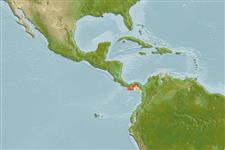Environment: milieu / climate zone / depth range / distribution range
Οικολογία
Θαλασσινό(ά); Υφάλμυρο; εύρος βάθους 0 - 50 m (Ref. 189). Tropical; 10°N - 5°N, 82°W - 77°W (Ref. 189)
Eastern Central Pacific: Panama Bay.
Μέγεθος / Βάρος / Age
Maturity: Lm ? range ? - ? cm
Max length : 18.7 cm TL αρσενικό/απροσδιόριστο; (Ref. 114986); μεγ. δημοσιευμένο βάρος: 49.80 g (Ref. 114986)
Short description
Κλείδες προσδιορισμού | Μορφολογία | Μορφομετρία
Ραχιαίες άκανθες (συνολικά) : 0; Εδρικές άκανθες: 0; Μαλακές εδρικές ακτίνες: 28 - 35. Body somewhat compressed, moderately deep. Snout pointed, about 1/2 to 3/4 eye diameter; maxilla moderate, tip somewhat bluntly pointed, reaching to middle of inter-operculum; gill cover canals of panamensis-type. Anal fin long, its origin under or slightly before dorsal fin origin. A narrow silver stripe along flank, about pupil diameter.
Occurs in coastal waters, probably tolerating lowered salinities (as in A. mundeola). More data needed.
Life cycle and mating behavior
Maturities | Αναπαραγωγή | Spawnings | Egg(s) | Fecundities | Προνύμφες
Spawn in school (Ref. 205).
Whitehead, P.J.P., G.J. Nelson and T. Wongratana, 1988. FAO Species Catalogue. Vol. 7. Clupeoid fishes of the world (Suborder Clupeoidei). An annotated and illustrated catalogue of the herrings, sardines, pilchards, sprats, shads, anchovies and wolf-herrings. FAO Fish. Synop. 125(7/2):305-579. Rome: FAO. (Ref. 189)
IUCN Red List Status (Ref. 130435)
Threat to humans
Harmless
Human uses
αλιεία: παραδοσιακή αλιεία
Εργαλεία
Special reports
Download XML
Διαδικτυακές πηγές
Estimates based on models
Preferred temperature (Ref.
123201): 27 - 28.1, mean 27.9 °C (based on 10 cells).
Phylogenetic diversity index (Ref.
82804): PD
50 = 0.5000 [Uniqueness, from 0.5 = low to 2.0 = high].
Bayesian length-weight: a=0.00490 (0.00277 - 0.00865), b=3.15 (3.00 - 3.30), in cm total length, based on LWR estimates for this species & Genus-body shape (Ref.
93245).
Τροφικό Επίπεδο (Ref.
69278): 3.4 ±0.5 se; based on size and trophs of closest relatives
Ελαστικότητα (Ref.
120179): Υψηλό, ελάχιστος χρόνος για διπλασιασμό πληθυσμού < 15 μήνες (K=2.78).
Fishing Vulnerability (Ref.
59153): Low vulnerability (10 of 100).
